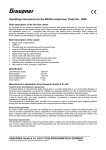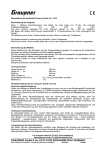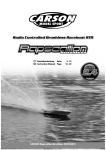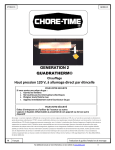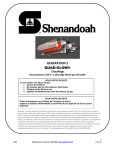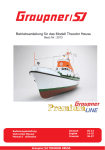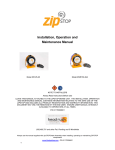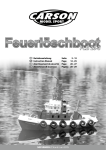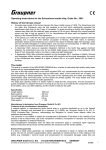Download Operating instructions for the MICRO MAGIC RTR HoTT
Transcript
Operating instructions for the MICRO MAGIC RTR HoTT model boat, Order No.: 2014.HoTT Brief description of the model • • • • • • • • • • • • • • • • • • Ready-made model (ARTR) The MICRO MAGIC RTR was developed to reflect advances in the MICRO MAGIC regatta scene, and represents a factory-assembled version of the boat for the ambitious skipper to enter in racing events The hull, deck, canopy and keel / mast socket are supplied as CNC-machined vacuum-moulded ABS parts, and are already installed and glued in place All RC components are installed in the hull at the factory GR-12 HoTT 2.4 GHz receiver already installed The model can quickly and easily be bound to any Graupner HoTT transmitter The rig is largely pre-assembled, so that it can be set up very quickly The sails are packed separately to protect them from creasing, and therefore have to be installed by the operator The keel fin and rudder are injection-moulded in glass fibre reinforced plastic to ensure very high rigidity Drag is lower due to the slightly reduced area and narrow profiles used for the fin and rudder Ready-made sail suit with sewn seams, consisting of lightweight white water-repellent sail fabric Stiff, lightweight rig consisting of CFRP tubing. A one-piece mast is employed to ensure a sufficiently rigid rig without a spreader The rig consists of newly developed high-quality plastic fittings which are also used in the kit version Factory-fitted jib trim servo, enabling the skipper to fine-tune the sail trim while the boat is on the water Reduced overall friction in the whole sail setting system thanks to the double-ended output lever with two return pulleys The model can be completed ready for the water in a very short time thanks to the high level of prefabrication Pre-painted hull, keel fin and rudder with decals already applied Set contents: vacuum-moulded ABS parts for hull, deck, canopy and two-part keel / mast socket, factoryfitted laser-cut wooden internal parts, boatstand, rudder and keel fin moulded in glass fibre reinforced plastic, cast keel ballast attached to the keel fin, various injection-moulded plastic parts, carbon fibre tubing for mast and booms, ready-made sail suit, polyester cord, small items, decal sheet, GR-12 HoTT 2.4 GHz receiver (Order No. 33506), building instructions in German, English and French. Specification Overall length approx. Beam approx. Overall height approx. All-up weight approx. Sail area approx. 535 mm 180 mm 980 mm 850 g 1450 cm² Manufacturer’s declaration from Graupner GmbH & Co. KG Content of the manufacturer’s declaration If material defects or manufacturing faults should arise in a product distributed by us in the Federal Republic of Germany and purchased by a consumer (§ 13 BGB), we, Graupner GmbH & Co. KG, D-73230 Kirchheim/Teck, Germany, acknowledge the obligation to correct those defects within the limitations described below. The consumer is not entitled to exploit this manufacturer’s declaration if the failure in the usability of the product is due to natural wear, use under competition conditions, incompetent or improper use (including incorrect installation) or external influences. This manufacturer’s declaration does not affect the consumer’s legal or contractual rights regarding defects arising from the purchase contract between the consumer and the vendor (dealer). GRAUPNER GmbH & Co. KG D-73230 KIRCHHEIM/TECK GERMANY No liability for printing errors. Technical modifications reserved. 1 09/2011 Extent of the guarantee If a claim is made under guarantee, we undertake at our discretion to repair or replace the defective goods. We will not consider supplementary claims, especially for reimbursement of costs relating to the defect (e.g. installation / removal costs) and compensation for consequent damages unless they are allowed by statute. This does not affect claims based on legal regulations, especially according to product liability law. Guarantee requirements The purchaser is required to make the guarantee claim in writing, and must enclose original proof of purchase (e.g. invoice, receipt, delivery note) and this guarantee card. The purchaser must send the defective goods to us at his own cost, using the following address: Gliders Brunel Drive, Newark, Nottinghamshire, NG242EG The purchaser should state the material defect or manufacturing fault, or the symptoms of the fault, in as accurate a manner as possible, so that we can check if our guarantee obligation is applicable. The goods are transported from the consumer to us and from us to the consumer at the risk of the consumer. Duration of validity This declaration only applies to claims made to us during the claim period as stated in this declaration. The claim period is 24 months from the date of purchase of the product by the consumer from a dealer in the Federal Republic of Germany (purchase date). If a defect arises after the end of the claim period, or if the evidence or documents required according to this declaration in order to make the claim valid are not presented until after this period, then the consumer forfeits any rights or claims from this declaration. Limitation by lapse of time If we do not acknowledge the validity of a claim based on this declaration within the claim period, all claims based on this declaration are barred by the statute of limitations after six months from the time of implementation; however, this cannot occur before the end of the claim period. Applicable law This declaration, and the claims, rights and obligations arising from it, are based exclusively on the pertinent German Law, excluding the norms of international private law, and excluding UN retail law. Important safety notes You have purchased a kit which can be assembled to produce a fully working RC model when fitted out with the appropriate accessories. As manufacturers, we at GRAUPNER are not in a position to influence the way you install, operate and maintain the model, nor the other components used in connection with the model. For this reason we are obliged to deny all liability for loss, damage or costs which are incurred due to the incompetent or incorrect use and operation of our products, or which are connected with such operation in any way. Unless otherwise prescribed by binding law, the obligation of the GRAUPNER company to pay compensation, regardless of the legal argument employed, is excluded. This includes personal injury, death, damage to buildings, loss of trade or turnover, interruption of business or other indirect or direct damages which are caused by the operation of the model. Under all circumstances and in all cases the company’s overall liability is limited to the amount which you actually paid for this model. The model is operated at the sole risk of the operator. To avoid injury to persons and damage to property please handle your model boat carefully and operate it conscientiously at all times. Before you run the boat for the first time it is important to check that your private third party insurance policy provides cover when you are operating model boats of this kind. If you are not sure, take out a special insurance policy designed to cover the risks of RC modelling. These safety notes are important, and must be kept in a safe place. If you ever dispose of the model, be sure to pass them on to the new owner. GRAUPNER GmbH & Co. KG D-73230 KIRCHHEIM/TECK GERMANY No liability for printing errors. Technical modifications reserved. 2 09/2011 The following points are important and must be observed at all times: • This model is not suitable for young persons under fourteen years of age. • The keel ballast bulb is made of lead! It is essential to dispose of the lead weight in accordance with current legal requirements when the model comes to the end of its useful life. It must not be discarded in the ordinary household refuse. If you are not sure where you can take scrap lead, ask your local authority for information (usually communal waste disposal sites). • NOTE: the electronic components, including the transmitter, receiver and servos, must not be discarded in the domestic waste. You must dispose of these items in the appropriate manner; ask your local authority if you are not sure (usually communal waste disposal sites). • The projecting parts of the model may be sharp, and the aerials and masts may cause eye injuries. • If the model is to be built by a youngster, a parent or guardian must monitor the assembly process, as tools and adhesives can be hazardous. • Please operate the model carefully when there are persons or animals in the water; always keep a safe distance between the boat and man or beast. • Never run your boat in a protected site, an animal or plant sanctuary or a site of special scientific interest (SSSI). Check with your local authority that the stretch of water you wish to use is suitable for model boats. • Never sail the vessel in salt water. • Never run your boat in adverse conditions, e.g. rain, storm, strong wind (above Beaufort 4), choppy water or strong currents. • As the model is designed for light-wind sailing, it should only be operated in wind strengths of 1 to 3 on the Beaufort scale (leaves moving in the wind). If the wind is stronger, the boat could heel severely and be impossible to control. Gusty conditions should also be avoided. • The model requires a breeze in order to move, i.e. in flat calm conditions the boat will just remain stationary on the water. Please bear this in mind when you are thinking about sailing the model. • Before you operate the boat, please ensure that the radio control system is working reliably. • It is important to check the range of the radio control system: switch the radio control system on, hold the transmitter in your hands, and walk about 50 m away from the boat. All the radio-controlled functions should continue to work normally at this range. • Ensure that the channel you intend to use is not already occupied by another modeller. Never run the boat if you are not certain that your channel is free. • Switch the model’s radio system off before carrying out any work on the boat. • Dry cells and rechargeable batteries must never be short-circuited, nor allowed to come into direct contact with water. • Remove all batteries from the model and the transmitter when you know you will not be using them in the near future. • Do not subject the model to high levels of humidity, heat, cold or dirt. • Secure the model and the transmitter when transporting them, as they may be seriously damaged if they are free to slide about. • Never operate the model on moving water (e.g. a river), as it could easily be washed away downstream if the wind conditions change. • If you have to salvage the model, take care not to risk your own life or that of others. • Check regularly that the boat is completely watertight, as it may sink if too much water enters the hull. Check the model for damage before every run, and ensure that water cannot penetrate the hull. • Allow the boat to dry out thoroughly after use. Care and maintenance • • Clean the model carefully after every run, and remove any water which gets inside the hull. If water gets into any of the RC components, dry them out and send them to your nearest GRAUPNER Service Centre for checking. Clean the model and the transmitter using suitable cleaning agents only. We recommend wiping with a lintfree cloth. Never use chemical cleaners, solvents, petrol, white spirit or similar. GRAUPNER GmbH & Co. KG D-73230 KIRCHHEIM/TECK GERMANY No liability for printing errors. Technical modifications reserved. 3 09/2011 Notes on the radio control system • • • • • • Before switching the radio control system on, please read the instructions supplied with the transmitter you intend to use to control the boat. The receiver is switched on and off by operating the On / Off switch. When switching the system on: always switch the transmitter on first, and only then the receiver. When switching the system off: always switch the receiver off first, and only then the transmitter. Check the model’s working systems in turn. If any of the functions do not operate in the direction you prefer, you can change them using the servo reverse facility at the transmitter: on simple transmitters this will be by means of mechanical switches; on more sophisticated types by software. Refer to your transmitter instructions for information on how to operate the servo reverse function. Never attempt to sail the model with flat batteries in the transmitter or model. The dry cells in the model are subject to quite heavy loads, and will be flattened fairly quickly; for this reason you will need to replace them more frequently than the transmitter batteries. If you are not sure whether the cells are still sufficiently charged, it is always safer to replace them. Your model shop will stock battery testers which you can use to check the state of your batteries. Notes on building the model • • • • • • • Please refer to the photos and the drawing when assembling the model. If you do not understand the technical terms relating to sailing boats, you can download a sketch showing the basic terminology from the Internet website www.micromagic-rc-segeln.de. Before you start building the boat, please take the time to study the plan and read right through the instructions for the boat and the transmitter. Please bear in mind that many tools can be dangerous if misused or handled carelessly. Deploy the receiver aerial as high up in the hull as possible, and wind the external part of the aerial round the backstay. Reception will be very poor if the aerial is positioned below the waterline, and effective range will be greatly reduced. Completing the rig requires a few knots; they can be secured with a small drop of cyano. If the circular reinforcing stickers on the sail come loose, stick them back in place using a drop of cyano. Assembly instructions • Assemble the parts of the boatstand, and apply glue to all the joints for additional strength. • The next step is to install the rudder system. This is accomplished by setting the rudder servo and the rudder blade to centre, and securing the tiller arm. Secure the two rudder linkages by tightening the shroud tensioners. Note that the control cords should only be tightened to the point where they are just taut; if you over-tighten them, the rudder servo may be overstressed. GRAUPNER GmbH & Co. KG D-73230 KIRCHHEIM/TECK GERMANY No liability for printing errors. Technical modifications reserved. 4 09/2011 • Insert the keel in the hull, and tighten the retaining nut at the top; it should only be hand-tight. • To form a connection between the transmitter and the receiver, the receiver must be bound (see following section ‘Binding’). Fix the end of the aerial to the edge of the deck opening with a piece of adhesive tape. • Check that the blocks on the sail setting lever are attached to the inner holes; unscrew and re-fix them if necessary. The blocks must be free to move on the lever. If you have to make any changes, take care not to twist the two sheets (see sketch). Insert the main boom, the swivel bracket and the aluminium tube in the opening in the deck. • • • Fit the mast in the opening in the main boom pivot. Locate the loops in the shrouds [E] and the backstay [D], slip them through the small holes in the figure-ofeight rigging eyes, then place all three under light tension. GRAUPNER GmbH & Co. KG D-73230 KIRCHHEIM/TECK GERMANY No liability for printing errors. Technical modifications reserved. 5 09/2011 • Fix the clew [e2] to the clamp bracket securely, then connect the main halyard [J] to the rigging eye at the masthead. Fix the sail in position using one of the lower mast rings. • Pass the Cunningham stretcher [C] through the main boom swivel bracket, and tie it securely to the sail tack [f2]; it should remain loose. Slip the loop into the rigging eye, taking care to position the shroud tensioner centrally between the eye and the mast. Now tighten the knot at the sail tack and secure it with a small drop of glue. • Slip the remaining mast rings through the holes in the luff [b2], and close them. GRAUPNER GmbH & Co. KG D-73230 KIRCHHEIM/TECK GERMANY No liability for printing errors. Technical modifications reserved. 6 09/2011 • Attach the jib to the jib boom. Tie the cord at the tack [f1] permanently to the eye on the forward jib boom swivel bracket, then screw the clew [e1] permanently to the clamp bracket. • Connect the two loops in the forestay to the small hole in the rigging eye at the mast swivel bracket. Adjust the position of the shroud tensioner to the point where the foot [c1] and the foot [c2] of the two sails are approximately in line. Now wrap the forestay round the weighted shaft, tie it, and secure the cord with a drop of cyano. Locate the loop in the topping lift [F] and connect it to the small hole at the same time. • Run the loop in the forestay [H] into the small eye, fit the cord through the eye on the opposite side, and then into one of the holes in the annular clamp. Insert a loop of the cord in the opposite hole, then tie the cords together lightly. Position the shroud tensioner centrally between the two eyes, tighten the knot fully, and secure the knot with a drop of cyano. The whole rig should now be placed under tension in such a way that the mast curves slightly towards the stern. Use the two clamp brackets to adjust the sails so that they adopt a slight belly under wind pressure. Adjust the depressor on the main boom in such a way that the sail is smooth and free of creases, then tighten the locknut to maintain this setting. • GRAUPNER GmbH & Co. KG D-73230 KIRCHHEIM/TECK GERMANY No liability for printing errors. Technical modifications reserved. 7 09/2011 • Use the RC system transmitter to adjust the sail setting lever to the “sails fully close-hauled” position. Run the main sheet over the return clamp bracket, set the sail central, and secure the sheet with the annular clamp. If you do not need or wish to de-rig the model for transport, we recommend that you route the sheet through the holes in the sleeve, in a similar way to the forestay, and then secure it with a knot (also applies to the jib). • Run the jib sheet through the hole in the end of the jib boom, and secure it with the annular clamps. With the mainsail fully close-hauled, set the jib to the “run out slightly” position (approx. 5°). Carry out a check of the radio controlled functions. Note that the jib trim only has a very small range; this is intentional, and is sufficient for the trim function. By default the jib trim and the rudder control are assigned to the right-hand stick unit, with sail control on the left-hand stick. If you wish to change this arrangement, you will need to re-connect the servo leads at the receiver. Install new dry cells, or fully charged rechargeable cells, and check that everything works according to your wishes. You can now place the canopy on the cockpit, secure it with the latches, and launch the boat for its maiden run. • • • Note: all the injection-moulded components used on the model are original Graupner parts as used on the racing MICRO MAGIC (Order No. 2014), so you can use these parts for any modifications or re-rigging of the model; the same applies to the polyester cord (Order No. 674). GRAUPNER GmbH & Co. KG D-73230 KIRCHHEIM/TECK GERMANY No liability for printing errors. Technical modifications reserved. 8 09/2011 Sailing Sailing a model yacht is not difficult once you are familiar with the inter-action between the wind direction, the boat’s heading and the appropriate sail settings. Before you sail the model for the first time, we recommend that you read all you can on the theory of sailing, e.g. by reading one of the many books on the subject. The following section just provides a short, basic introduction to the subject. The various points of sailing (see sketch: specialist terms are printed in italics) A sailing boat can never sail directly into wind (black arrow (W)). In the 90° sector (dark grey area) the sails will always flap about (shiver), and generate no forward thrust. Only when the boat bears away to about 45° off the wind direction will it start to p ick up speed with the sails close-hauled (transition from dark grey area to light grey area (2a) to (2b)). This heading is termed luffing. A sailing boat can only make headway into the wind on this course and with the sails close-hauled; the procedure is known as tacking, and involves sailing in a zig-zag pattern: for a while on the port tack (mainsail on the left-hand (port) side of the boat (2a)), then, after going about (the boat’s bow turns through the wind, from position (2a) via (1) to (2b)), for a while on the starboard tack (mainsail on the right-hand (starboard) side of the boat (2b)), etc. Fast, efficient tacking with a sailing boat demands a good eye and considerable manual skill, and ranks as the true art of sailing. The other courses are not so demanding. If the wind is blowing from the side, the sails are slackened (paid out) just to the point where they no longer shiver, i.e. around 30° to 45° relative to the boat’s longitudin al axis. This course is known as sailing with wind abeam ((3a) wind abeam on the port bow / (3b) wind abeam on the starboard bow). If the boat bears away even further (bearing away: the boat turns away from the wind, i.e. the stern turns increasingly in the direction of the wind (II) / luffing: the boat’s bow turns increasingly towards the direction of the wind (I), it ends up on a course with free wind, where the sails are paid out to about 60° to the boat’s centreline (4a / 4b). The boat only attains its maximum speed on these two headings. If the boat is sailing directly away from the wind (downwind), we speak of running before the wind. On this course the sails should be paid out as far as possible (approx. 90° to the boat’s centreline). Differe ntial pressure conditions on the sails cause the jib to turn to the opposite side to the mainsail by itself, but this situation can also be generated deliberately by small rudder / course corrections. If the wind is or becomes too strong, the bow of a sailing boat can very easily be pushed under the water on this heading. If the boat is sailing with free wind, and is then brought into a position before the wind using the rudder (bearing away), before being steered back to a free wind heading using the rudder (approximately at right-angles to the former course with free wind), the boat is said to have performed a gybe. Gybing is complete when the main boom, paid out a long way, swings from one side of the boat to the other. Steering characteristics / sailing characteristics Variations in wind pressure make it difficult for a performance-orientated sailing boat to maintain its course by itself; gusts of wind may cause it to luff up automatically, i.e. turn into the wind to a greater or lesser extent. This can be prevented by slightly paying out the sails in good time, and also by applying slight opposite rudder if necessary, until the gust is past. If the boat should bear away, the sails should be run out at the same time as the necessary corrective rudder movement is applied. Otherwise, in fairly strong winds the boat will tend simply to continue stubbornly in a straight line, ignoring the corrective rudder commands. Please note that any sailing boat will turn uncontrollably into the wind if the breeze is too powerful. This means that the sail area is too great; if there is no alternative smaller sail suit available, sailing is not possible under these conditions. NOTE: the two lateral keels are not required for sailing, and tend to slow the boat down, so we recommend that you remove them for sailing. The full-size boat on which the model is based is typical of this racing class, and for this reason the lateral keels are also present on the model, although they are not required for actual sailing. GRAUPNER GmbH & Co. KG D-73230 KIRCHHEIM/TECK GERMANY No liability for printing errors. Technical modifications reserved. 9 09/2011 Sail trim The foresail of a yacht should always be slightly more open than the mainsail when close-hauled (mainsail around 10° midships: foresail about 12° close-haule d) so that the airflow from the foresail is directed onto the rear face of the mainsail, rather than being deflected into the front of it. The optimum difference varies according to the wind and weather, and can be adjusted on the MICRO MAGIC RTR by adjusting the sheets and by securing the cleats either on the main boom or the jib boom. If the boat does not maintain its course in a constant light wind and at a slight angle (heel) when luffing, then the trim of the rig is not correct, i.e. the centre of pressure of the whole sail area needs to be altered. In the case of the MICRO MAGIC RTR this is achieved typically by adjusting the mast rake (inclination - typically as shown in the drawing on the right): Situation / Behaviour Windward tendency (the boat tends to turn into the wind by itself (it luffs up)). Leeward tendency (the boat tends to turn away from the wind by itself (it bears away)). Solution / Adjustment The mast is raked too far back, and needs to be tilted forward (loosen backstay, tighten forestay). The mast is raked too far forward, and needs to be tilted further back. Caution: a boat’s tendency to turn into or away from the wind is also affected by the sail settings; for instance, if the mainsail is set too tight by the kicking strap, or if the foresail is set too close-hauled or too far open. In general terms sailing boats offer their maximum performance if they have a slight windward tendency. The optimum setting can only be established by experimenting; please bear in mind that it also varies according to the weather conditions. Binding Before the receiver can be operated by a HoTT transmitter, it must be bound to the Graupner HoTT 2.4 GHz RF module. This is the procedure in detail: • Switch the transmitter and receiver on (the receiver is switched on as soon as you connect the battery and move the On / Off switch to the ON position). • Hold the SET button on the receiver pressed in for at least three seconds; the flashing green LED then stops flashing. • Initiate the binding function at the transmitter (see transmitter instructions): after about one second the receiver is bound to the transmitter, and the receiver LED glows a constant green. • If the binding process fails for any reason, the transmitter LED will glow red instead of blue, and the receiver LED fails to light up. If this should happen, repeat the procedure. Maiden run Wait for a day with optimum wind conditions, and seek out a stretch of water where you can easily salvage the boat. Charge up the batteries, and check the model’s working systems. Ensure that all parts are securely attached - that applies to the Cockpit canopy in particular! Now you are ready for the boat’s maiden run. Be cautious at first, and take your time to get used to its sailing characteristics and handling. Don’t sail the model too far from the bank initially. All of us at GRAUPNER hope you have many hours of pleasure building and running your MICRO MAGIC RTR HoTT. GRAUPNER GmbH & Co. KG D-73230 KIRCHHEIM/TECK GERMANY No liability for printing errors. Technical modifications reserved. 10 09/2011










